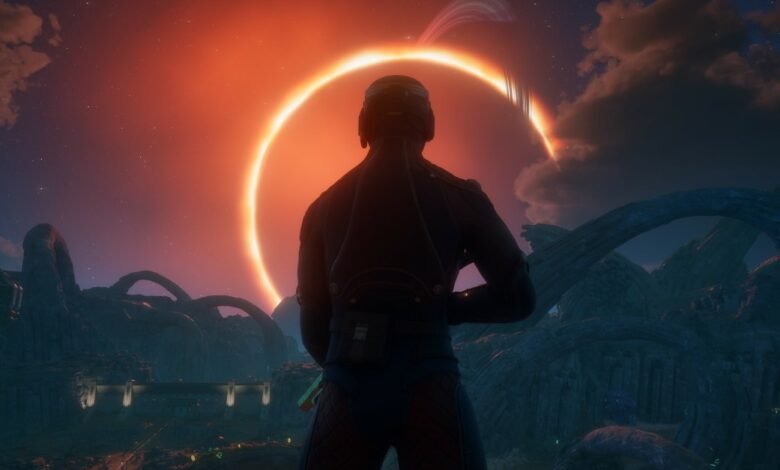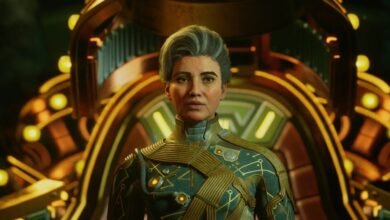The Outer Worlds 2’s Satire Faces a Microsoft Problem

▼ Summary
– The Outer Worlds 2 features a corporate merger forming Auntie’s Choice, which operates as a cruel feudal power prioritizing its military business over retail.
– The game’s fictional corporate satire parallels real-world events, including Obsidian Entertainment’s acquisition by Microsoft and the company’s subsequent focus on AI and cost-cutting measures.
– Developers describe the game as exploring themes of power, control, and institutional influence, expanding on their history of creating RPGs with factional conflicts and societal critique.
– Obsidian acknowledges the irony of critiquing corporate power while being owned by Microsoft but states they’ve received full creative support without interference.
– The game includes direct commentary on propaganda and information control through in-game elements like the Ministry of Accuracy, mirroring real-world concerns about media manipulation.
From its opening moments, The Outer Worlds 2 plunges players into a corporate dystopia where the newly formed “Auntie’s Choice” exemplifies unchecked power. This merger of Auntie Cleo and Spacer’s Choice creates a monolithic entity treating its workforce like disposable assets, prioritizing military contracts over consumer goods. This fictional corporate consolidation intriguingly mirrors the real-world circumstances of the game’s own developer, Obsidian Entertainment, which was acquired by Microsoft just before production began.
The studio now operates under a corporate parent whose recent gaming strategy has been marked by significant price increases, workforce reductions, and a pronounced pivot toward artificial intelligence. Despite this environment, Obsidian’s latest RPG boldly critiques the very systems it inhabits. Players step into the shoes of an operative within a disturbingly cheerful, authoritarian organization, caught in a power struggle between a ruthless megacorporation and an oppressive government. The game’s narrative seems poised to offer sharp commentary, though the developers themselves maintain a more nuanced stance.
Creative director Leonard Boyarsky and game director Brandon Adler emphasize that their primary goal is crafting an enjoyable experience, not creating a direct response to current events, given the lengthy development cycles of major games. They do, however, acknowledge the topical nature of their story. Boyarsky explained that his work, often with co-creator Tim Cain, consistently explores the dynamics of power. “We’re expanding on that continually,” he noted, highlighting a career-long fascination with how individuals and institutions behave when granted authority.
The creative DNA of Boyarsky and Cain, who co-created the Fallout series and worked on revered titles like Vampire: The Masquerade – Bloodlines, is deeply embedded in the genre. They helped pioneer the modern RPG tradition where player agency is tested through complex factional conflicts and systemic distrust. The Outer Worlds franchise itself is a spiritual successor to Fallout, each using an alternate history to craft a bizarre future. While Fallout envisioned a 1950s atomic age gone horribly wrong, The Outer Worlds imagines a timeline where anti-trust laws never emerged, allowing industrial titans to dominate society for centuries.
This sequel amplifies the corporate satire into something notably darker. Within the first quarter-hour, players encounter a slick corporate mascot for a defense contractor-owned brand, watch a propaganda-filled television segment reminiscent of Starship Troopers, and view an advertisement openly encouraging citizens to spy on one another. A more sinister undercurrent connects corporate overreach directly to the mechanics of fascism, suggesting a bleaker and more critical perspective than its predecessor.
When asked about the fascist themes, Boyarsky offered a philosophical take. “We all end up in situations where we don’t have control. Even people in power are as much victims of the system as anybody else,” he reflected. He described a world where individuals, shaped by their upbringing and societal narratives, often find themselves trapped in circumstances beyond their command, simply trying to make the best of a bad situation.
He believes video games are a uniquely powerful medium for exploring these ideas, attributing The Outer Worlds’ specific tone to a blend of his and Cain’s interests. While Cain was drawn to the comedic, Futurama-inspired setting, Boyarsky wanted to retain that humor while steering toward more challenging and serious subject matter. “We all tell ourselves stories,” he stated. “That’s how we cope with reality… But when people co-opt that story, they can control you very easily.”
These potent themes are layered with undeniable irony, given that Obsidian crafts its anti-corporate narrative while being owned by one of the world’s largest corporations. Boyarsky is acutely aware of this contradiction. “The irony was not lost on us when we were in the middle of making the first game. Railing against corporate power and all this stuff, and we were bought by Microsoft!” he admitted. However, he was quick to add that the developer has received nothing but support, with no directives from Microsoft to alter its creative vision.
While Microsoft may not have interfered with the game’s development, the company demonstrated clear preferences regarding the public conversation around it. As the interview touched on themes of power and the plight of the disenfranchised, themes that felt particularly resonant in light of Microsoft’s business dealings with the Israeli Ministry of Defense, a company representative interjected. The rep redirected the discussion, stating that Microsoft’s official statements were available online and that the conversation should remain “focused on the game.”
Focusing on the game reveals telling details. An early quest can lead players to the “Ministry of Accuracy,” a propaganda department where workers “sanitize” regional reports to align with the ruling Protectorate’s official narrative. It’s a clear case of art imitating life, or perhaps for Obsidian, it’s life that continues to imitate its art.
The Outer Worlds 2 is available now on PlayStation 5, Xbox Series X/S, and PC.
(Source: The Verge)
